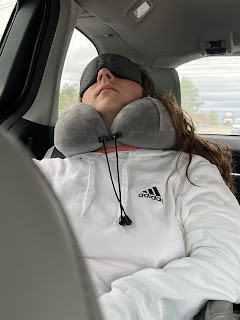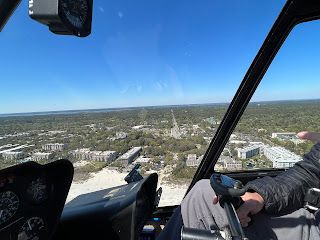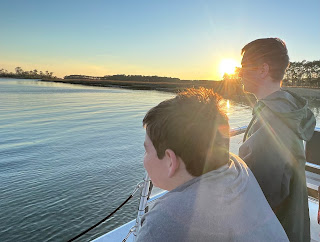👻 Spring break 2023: Savannah or bust!👻
He's my King of the Road.
We put the pedal to the metal at 5am to head to Sister's. That crazy early time works best because the kids will sleep for a large portion of the drive.

More often than not, Zeke is sleeping; I just happened to catch him awake.
Birmingham is right on the way to Savannah. Oddly enough, Sister and Tony had plans to be out of town the weekend we drove through. Nick, Alex and Sabin were great hosts for the night.
Then we continued our journey to Savannah. A big storm with torrential rain chased us for several hours. I kept thinking we would drive out of it, but it continued right on our tail. We finally got ahead of it shortly before we hit Savannah but it took us an extra hour to get there.
Segways were our very first stop.
Thankfully the weather held out long enough for us to take our tour.



Savannah, established in 1733, was Georgia's first city. The beautiful streets are lined with huge oak trees adorned with Spanish moss draping down. The picturesque city squares are surrounded with monuments, museums, churches and famous forts of the Revolutionary and Civil War eras.
Former general James Oglethorpe of England devoted himself to helping the people in debtors' prison. After visiting America and returning to his homeland, he proposed a plan of creating a city in America to the King of England. Hence the birth of America's first planned city. He suggested a settlement in America called 'Georgia,' named after King George II, where the prisoners could learn trades and work off their debts. Oglethorpe prohibited four things in the settlement: slavery, lawyers, rum, and Catholics. Those prohibitions, however, did not last long. The Cathedral of St. John the Baptist was constructed in 1859.

When we picked our destination for spring break, I had the family watch Midnight in the Garden of Good and Evil. It is based on a true story that took place in Savannah in the 1980s. Basically a socialite murdered his servant/secret lover, presumably in self-defense, in this home after a quarrel. He passed away from a heart attack in the home shortly after his acquittal. This is the Mercer-Williams House, where the infamous events occurred.
All of the azaleas in bloom reminded me of Korea.
As soon as we returned our Segways, the rain caught up to us. We snuck inside a candy shop to seek shelter.

The next day we took a city tour by bus. It was not an exciting as the Segways but full of interesting info.
St. Paul's Greek Orthodox Church was constructed in 1897-98 as a memorial to General Lawton and his daughter. He was a quarter master general in the Confederacy, among various other leadership positions.
Savannah has many walkable neighborhoods with several green parks located in a grid pattern, nestled among residential and commercial blocks. General Oglethorpe intentionally planned the city to have these repeating squares as public green space accessible to every citizen, which had been the exclusive privilege of royalty and aristocrats in Europe. The squares were also used for the militia to practice drills. As you stand in a square, you can see the neighboring squares in each direction.
There were originally 24 squares, 23 of which remain today. They are filled with statues, fountains, grass, flowers, huge trees with flowing Spanish moss, and lots of pedestrians.
Chippewa Square was named after an important battle in the War of 1812. A statue of General Oglethorpe is the centerpiece of this square. He befriended Tomochichi, the leader of the Yamacraw Indians, encouraging the settlers and the Native American tribe to live together peacefully. There is also a large stone monument dedicated to Tomochichi in this square.
This also happens to be the location for the bench in Forrest Gump. The bench was placed here for the movie and removed after filming.
This gorgeous home with the "Temple of the Wind" columns is called the Harper Fowlkes House. The original owner went bankrupt. The purchaser used it for entertaining in 1843. Two years later the mortgage of $15,000 was paid off as a wedding gift.

The famous Leopold's Ice Cream was founded by the three Leopold brothers in 1919. In all honesty, the wait in line was probably not worth it, but I had to try it while we were there. Look closely at the reflection in the window and you will spot me and the kids.
John Wesley came to Savannah at the request of Oglethorpe. Wesley founded the first Sunday School while in Savannah around 1737. This statue was erected on the spot that is believed to be Wesley's home.
The Telfair Family Mansion, built in 1818, was donated by Mary Telfair upon her death in 1875. Her father was a Revolutionary patriot and an early governor of Georgia. At this site in 1776 Major Joseph Habersham walked in on the English governor at the time and announced, "Sir James, you are my prisoner." A bit of trivia for my mom: Habersham later became Postmaster-General of the United States.Mary Telfair specifically instructed there were to be no parties in her home, which is now a museum. Once a soiree was thrown in the museum and the roof caved in. Was it the ghost of Mary, reminding them of her wishes?As stated earlier, there is much folklore of ghosts and paranormal activity in Savannah. It was believed that the hainted, or haunted spirits were unable to cross water, so people painted their houses haint blue to ward off the evil spirits. There are many haint blue houses and porch ceilings to this day.
Rising 70 feet in the air, the dome of City Hall was originally made of copper but was guilted with sheets of 23-karat gold leaf in 1987.
Near River Street stands The Waving Girl. For 44 years, from 1887 to 1931, Florence Martus, along with her collie, greeted ships entering Savannah by waving a cloth during the day and a lantern when it was dark. Her fame spread and captains would return her greetings with a blast of their horn. To this day many ships sound a salute to her statue. Her story was romanticized by saying that she was waiting for her true love to return from sea; however, Ms. Martus herself denied that story, stating that she began waving at the ships for her entertainment.
An urban legend suggests that this room along River Street was a holding facility for enslaved African Americans to be transported through Savannah's port in the 1800s. Historians claim there is no evidence of this to be true...
The terra cotta winged lion statue stands in front of what was once the Cotton Exchange building. It was constructed in 1886 during the era when Savannah ranked first as a cotton seaport on the Atlantic and second in the world.
The Old Exchange Bell is believed to be the oldest bell in Georgia, dating back to 1802. Imported from Amsterdam, it hung in the City Exchange. In its day, the bell signaled the closing time for shops and was rung by a watchman when fires broke out.

This monoment paying homage to World War II is known as "The Cracked Earth." The two halves of the globe are split, representing the conflict of a world divided.


We were supposed to go on a bus/boat tour of the city. Due to a lack of communication on the boat departure time, we didn't get to take our boat ride. (This is not the boat we would have been on, but a large vessel passing by.)
Tybee Island was our home away from home whilst in Georgia. It is located about 20 miles from downtown. The entire island is only three square miles, with less than 3,500 citizens occupying it year-round.
Tybee Island was our home away from home whilst in Georgia. It is located about 20 miles from downtown. The entire island is only three square miles, with less than 3,500 citizens occupying it year-round.

It was way too cold for me to swim, but Daisy and Eli gave it the ole college try.

We returned in the night to learn more about 'America's Most Haunted City.' The reasons for these hauntings were listed on one website as: bloody battles, deadly diseases, fearsome fires, mysterious murders and savage slavery.
The Andrew Low House was a stop on our tour.
The interior of the house is decorated with some original furnishings as well as others dating around 1850. We were told of eerie stories occurring in the mansion. Our tour guide said she personally saw the doll heads in this room move to stare at her late one night.
This piece of furniture is actually a piano.
Ghostly stories are associated with this mirror. If you zoom in the the left one has to wonder if that is me or an apparition, because it looks pretty freaky.
The Hamilton Mansion was the first residence in Savannah with electricity (the owner worked for Brush Electric Power and Light Company). In 1883 spectators were afraid the house would explode as they witnessed the porch light turn on for the first time.

This home has a ghost story of a guard that was shot who returns to the home. There are many stories of ghosts walking around, kids heard laughing in the halls, etc. of many of these old, beautiful houses. One legend claims a woman died at the table drinking her coffee; the son's girlfriend came down one morning and had an abrupt conversation with his mother. When the son/boyfriend said his mother died a few years ago the girlfriend was out of there. The next family kept finding used coffee cups in the kitchen. They left a note that gave the son's new address and they never found coffee cups again. You can decide if that is true or embellished, but that's what they claim.
Established in the 1750s, today there are only 700 graves in Colonial Park Cemetery. It is estimated that 12,000 people were actually buried here. It is said that many of the graves were paved over when creating adjacent Abercorn Street and located under the sidewalks around the cemetery.
The cemetery grew quickly in the 19th century when yellow fever claimed many lives. Union soldiers used it as a campground during the Civil War, when several headstones were damaged, including bullet holes that are still there today. It is claimed that many people see shadowy figures walking the grounds.
We did not see any shadowy figures lurking about, but this weird glowing green object appeared in one of my pictures.
If you use your imagination there is a white shadowy figure standing in the background of this picture. If you zoom in, however, you can tell it is just a headstone.


After hearing ghost stories, we went crab hunting in the dark on the beach. There were no crabs to be found, nor any ghosts.
We wrapped the night up with a game of Trash Can.

We wrapped the night up with a game of Trash Can.

I booked a few activities in Hilton Head for the next day. By water, it is only 12 miles. I did not realize that by car it is 1.5 hours away. We made a whole day of it and we started at Cross Island Bridge.
Whilst waiting for our guide, the kids panned for gold. When we returned there was a large group of people waiting for their tour. None of them, including the little kids, were panning for gold. Eli said it was embarrassing that not even the littles were playing in the sand like them.
We kayaked Broad Creek in search of local wildlife.
Hilton Head ranks as one of the 'Ten best dolphin sighting destinations in North America.' We were successful in our quest.
Dolphins can reach speeds of over 18 miles per hour and make up to 1,000 clicking noises per second. The clicking sounds are a form of echolocation to search for food. They don't have vocal cords, though. All the sounds come through the blowhole. We got pretty close but we could not hear the clicking sounds.
Dolphins shed their outermost layer of skin every two hours. 😲 They can submerge and hold their breath for up to 15 minutes. We always saw two at a time--I'm not sure it was always the same two or not. If they were submerged for 15 minutes, then it definitely was more than two.

Their dorsal fin is as unique as a human fingerprint. We could tell this one guy apart because his fin was sort of flopping over.
While most dolphin pods migrate seasonally, Atlantic Bottlehead dolphins claim the South Carolina coast as their home due to the year-round mild temperatures.
Our next adventure proved to be everyone's favorite--a helicopter ride!
Hilton Head Island was named after Captain William Hilton. In 1663 he identified a headland near the entrance to Port Royal Sound.
This is Coligny Beach, the island's most popular, from the air.
The island is only 12 miles long and five miles wide. Hilton Head has fewer than 40,000 year-round residents, yet it entertains over 2.5 million visitors a year.

We also saw Cologny Beach by land.
The city dubs it a beach park, because there are so many amenities.
Eli, Abe and I like to watch a TV show called Murdock together. I found a water fountain with the name, so I had to get a picture together with it.
We couldn't resist treating ourselves to some ice cream.

Stoney Baynard ruins are a reminder of the history of Hilton Head. The plantation, including a main house, slave quarters, and a kitchen, was built by Captain Jack Stoney in the 1790s. One story says that in 1840 Stoney lost the property to William Baynard in a poker game, while another story says it became property of the bank and Baynard bought it.
Baynard raised his family in the house until Union forces invaded Hilton Head Island in 1861, when the family evacuated the property. The residence was raided and served as Union headquarters during the Civil War. Shortly after the war, the house caught on fire. Surprise, surprise, people claim to see the ghost of Baynard. Some even claim to see his entire funeral procession.
The home was 1.5 stories tall and 1885 square feet. The 'basement,' used as storage, was on ground level.
It's hard to imagine this being an impressive home, but historians drew a picture of what they determined the house to look like. The photo that I took above is standing on the right side of the home.
The walls were made of 'tabby.' The name is Spanish and comes from the word "tapia," which means mud wall. Tabby cement was made from oyster shells, sand, water and lime.
A stucco-like plaster was applied to the walls after the tabby dried to protect it from moisture. You can see the plaster in the picture below.



The final activity of the day was a sunset dolphin cruise.
We departed from Calibogue Sound. Look at all of these pelicans on the port.
Harbor Town Lighthouse was built in 1970. The people thought it was a waste of money because there was no need for a lighthouse in that particular location. In time the red and white striped lighthouse became a Hilton Head landmark and is now the island's international symbol.
We learned that a sound is a narrow stretch of water separating an island from the mainland or connecting two larger bodies of water.
After seeing dolphins much closer on the kayaks, this was not as exciting. But the people on the boat had obviously not been kayaking with dolphins, because they oooohed and awwwwed when we caught glimpses of the fins.
One last sunrise on our final day.

On the drive home we stopped in at Sister's again. This time she and Tony were there, too. 😊Ghostly or not, another DanFam5 spring break is in the books.
[March 11-16]
Forsyth Park Fountain is one of Savannah's most well-known icons.
The park began as 10 acres in the 1840s and has grown to 30 acres. It is the city's largest and oldest park. It was named after Georgia's 33rd governor John Forsyth.
The large Confederate monument honors the soldiers who died during the Civil War. It proudly stands at 48 feet tall, plus the bronze statue of the Confederate soldier, making it one of the oldest and largest Confederate monuments in Georgia. In 1875 the Ladies Memorial Association held fundraising events like bake sales to earn $25,000 to create it. Interestingly, the women who developed this monument went to great lengths to avoid using any material or labor from the states that supported the Union in the Civil war. The monument was created in Nova Scotia and shipped directly to the city without touching the ground of the North. The soldier is orientated towards the North as a symbolic gesture of defiance.
Forsythe Fountain was ordered in 1858. That's right, ordered. It was ordered from an iron foundry catalogue. There are three other fountains just like it in located in New York, Indiana and Peru.
If you look closely you can see that the water was tainted green for St. Paddy's Day.
Our final stop in Savannah was Bonaventure Cemetery.
Our final stop in Savannah was Bonaventure Cemetery.
It began as a private cemetery called Evergreen Cemetery in 1846 and became public in 1907 when the existing cemeteries were nearing capacity. It is the largest in Savannah, spanning well over 100 acres. It is gorgeous, containing blooming trees and bushes, along with large oak trees (some said to be over 250 years old) adorned with Spanish moss.

The cemetery sits on the site of the former Bonaventure plantation, which means good fortune. The daughter of the original owner Mary and her husband Josiah Sr. were Loyalists, and they helped the Royal Governor escape back to England by hiding him at Bonaventure Plantation until he could board a ship home. They were eventually seen at traitors, stripped of all their land and fled the country. The man who purchased the plantation sold it back to Josiah Jr. a few years later. The first burial plot belongs to Josiah's wife Harriett and dates back to 1802.
Bonaventure was designed as a traditional Victorian cemetery with curving pathways, lots of trees and grassy areas. During the Victorian era, cemeteries were considered gardens and were seen as a place to gather. Families would spread out blankets on the lawn and enjoy Sunday picnics with their deceased relatives. It is still seen as more than a cemetery; you can actually reserve a spot for your wedding on the website.
There are a few headstones that have small rocks on them. Some believe that the rocks prevent evil spririts and demons from entering the burial site and taking possession of their soul, while others believe putting stones on the grave will keep the soul down in this world. However, according to the Bonaventure Historical Society, leaving rocks is an old Jewish tradition of showing visitation, similar to leaving flowers. Rocks last longer and have more permanence. There are rocks on the short headstones in the middle of the picture.
Here it is, zoomed in.
There are a couple of notable grave sites that I wanted to see. As you can imagine, with 160 acres, there are a lot of headstones! We lucked out and found the two that I was interested in. The first was Gracie. Her father was a popular hotel manager. In 1889 Gracie suddenly died from pneumonia at just six years old. She had posed for an Easter picture a few days before her death in her new Easter dress. Her parents commissioned a sculpture to carve a statue of her exact likeness in her fancy dress. Her monument also includes a tree cut in half. There are a few stones with these cut trees throughout the cemetery, symbolizing a life cut short. Gracie's headstone is so popular that it is fenced off and includes a stone with a description. People still leave small trinkets and gifts for her.
The second stone I wanted to find belonged to Charles Mills.This grave is special because it is a 'dead ringer.' Literally. During the yellow fever epidemic, it was learned that some people were buried alive because their comas were so deep that they were mistaken for dead. So the 'graveyard shift' was designed to listen for those who were 'saved by the bell.' A string in the coffin was attached to a bell outside the coffin. Most of the bells in Bonaventure Cemetery were made of tin or metal and later salvaged for use in military production during World War I. Mr. Mills was wealthy and insisted his bell be cast in bronze, so his bell still remains next to his stone.
One way to show wealth of the deceased and their family was to raise the lettering instead of engraving it.
Another sign of wealth was to make tall obelisks. The obelisks in Bonaventure continued to grow in height over the years until one reached a height of 55 feet. After that they capped the maximum height at 5 feet.
We saw many graves of children like the small cross below. The mortality rate in the 1800s was significantly high; only 54% of children made it to their 5th birthday.
Statues throughout the cemetery are said to represent the seven virtues: chastity, temperance, charity, diligence, patience, kindness, and humility. There is also symbolism in the feet of these statues. If the feet are bare, then the family thought their loved one was walking with Jesus.
Angel statues represented the idea that the deceased was welcomed safely into heaven in the afterlife.[March 11-16]















































































































































No comments:
Post a Comment